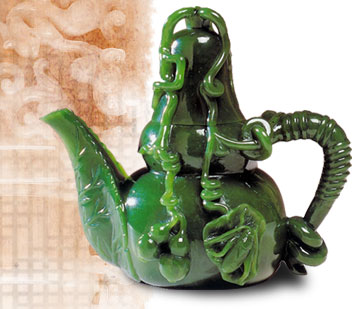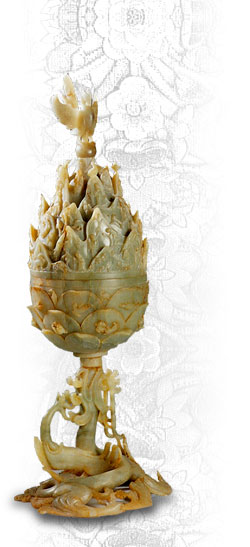| Diamonds reproduce their splendor by consuming sunlight, but jade recreates its luster by tasting moonlight. Diamonds flash their sparkle and glory for the entire world to see while jade invites that soft beauty inwards, to the most deepest and private part of itself. That is why many Westerners cherish the former whereas many from the Far East prefer the latter. To compare the two further, diamonds are gems symbolizing the virtues of the Western world, which values expressing one’s own ideas or feelings openly, while jade represents the Eastern ideal of modesty as the most valuable quality of all. In the East, jade is not regarded as a simple jewelry but as a gem that has been honored as the heart and soul of the universe, created from the quintessence of the cosmos coalesced. In the Book of Rites, one of the Five Confucian Classics, ancient Chinese sages highly praised jade by comparing its noble character with the four virtues of which a man of honor should be equipped: goodness, righteousness, wisdom and courage. Since then, jade has continued to be associated with the most respectable qualities a man can possess. As well, jade works have been used widely for use in people’s daily lives, from personal ornaments to items for religious events, and even priceless treasures. Archaeological relics excavated from the tombs of ancient Chinese kingdoms such as Shang and Zhou include many jade pieces, demonstrating the belief that jade works buried in tombs with the dead would ensure a prosperous life in the underworld. With its elegant color and warm, soft character, jade has also been loved by Koreans, who think the gemstone perfectly matches their personality: polite, patient and determined. In Korea, jade has been said to be a mysterious stone that brings good health, long life and good fortune, and has been used as a symbol of royal authority or the royal family. In fact, Koreans used a word meaning ‘jade’ for anything related to the king or kingship, for example, by calling the throne a ‘jade seat;’ the king’s hands as ‘jade hands;’ his face as a ‘jade face;’ his walk as a ‘jade walk;’ and his seal as a ‘jade seal.’ Jade has been loved extensively in Korea even among the common people, so much so that they used the word, jade, for newly-born baby boys by calling them ‘jade boys’ and gave the word to the name of their daughters. Korean people also believed that jade had the magical power of dispelling diseases and evil spirits, and some even used it as an ingredient in certain medicines. The tradition still exists, and some try to heal diseases by the mysterious energy believed to disseminate from jade. The beneficial effect of Korean jade on the human body has recently been known in foreign countries. In 1999, a group of Ukrainian children, all victims of the accident at the Chernobyl nuclear power plant, visited Chuncheon, the city where the Korea’s largest jade mine is located, and received a special ‘radioactivity clean-up’ program that involved drinking ‘jade spring water’ and wearing clothes soaked in jade energy. The program was found to have improved the health of the children. mysteriously beautiful colors that appear cold but actually are warm and soft to the touch. As modern living began to demand diversity even in the art of jade carving that had lasted for several thousand years on the peninsula, the tradition is now expected to continue to evolve from producing items for daily use to creating genuine works of art. Jang Ju-won, Master Craftsman of Jade Carving, is a leading Korean jade carver who actively takes up the new challenges of our time. View the master's works |
||||||||||
|


















